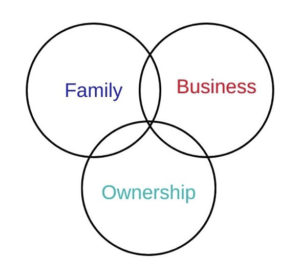
15 Apr Understanding the Intersection Between Family, Business and Ownership
Life can be stressful. The family business is where it all comes together: family pressures, ownership demands and business needs. When planning for the future, understanding the intersection between these three segments can lead to a different perspective on managing these needs, as well as the dynamics at work.
Each of the sections in this diagram represents a different group of stakeholders and participants. As you consider your options, it’s important to keep each of these segments in mind:

1. Family members who don’t work in the business or have ownership of it
This group includes everyone who is actually considered “family,” from spouses, children and parents to second spouses, stepchildren and even close family friends. This group is interested in the business not only because their lifestyle is supported by income from the business but also because their children may have career opportunities there one day. If they are spouses of major stakeholders, these family members may have a lot of influence over what happens with the business.
2. External investors
This group is comprised of investors who are not part of the family and are not employees. Their interest in the business is solely financial: They are looking for a return on their investment and an eventual payout. They are not interested in family dramas or excuses.
3. Management and workers
This group is the employees. They aren’t related to the family and hold no ownership in the business. They may be interested in job security and career advancement opportunities. They may be wondering about family members that move too quickly through the ranks.
4. Non-working family owners
This group is made up of family members who have an ownership stake but don’t actually work in the business. They may want some control over the business, either due to their family attachment (or rejection), and they may rely on income from the business to support them financially. But they also may not understand the business fully since they aren’t involved in day-to-day operations.
5. Employee owners
During startup, many employees are offered shares in the business in lieu of higher salaries. These non-family members who have shares in the business and continue to work in the business also have a stake. They may be extremely loyal employees, similar to the family members. But they also may need to suddenly cash out of the business for their own personal reasons.
6. Family employees
On the flip side, there may be family members who work in the business but don’t have any ownership share at all. They may share a viewpoint with other employees, such as concern about career opportunities, but they also may be silently (or not so silently) hoping for an ownership stake.
7. Working family owner
At the centre of the circle is the working family owner, the one with an interest in everything. This person may find it challenging to make decisions, especially when it comes to a succession plan, because of competing interests.
The working family owner has a tough job. Conflict is everywhere in a family business: all the children want to inherit control, or they are frustrated because their spouse or parent spends “too much” time at work, or they want nothing to do with the business but aren’t interested in supporting themselves independently.
The working family owner already knows that what is good for the business may not be the best choice for the family, and vice versa. It can be stressful.
If you’re the working family owner, learn to navigate the conflicts to achieve better outcomes. Keep these tips in mind:
1.Embrace the conflict. Don’t be afraid of it. It’s through conflict that successful business owners work through something difficult to achieve a desired outcome. As the working family owner, you must approach the conflict calmly and directly, rather than avoiding it and hoping the conflict disappears.
2. Learn about other perspectives. Listening to each contributor’s concerns and priorities can lead you to greater understanding. Everyone has a role to play. As the working family owner, your job is to take these perspectives into account while still making the best decision possible.
3. Stay focused. Be sure not to wear too many hats. When there are too many competing priorities, it becomes impossible to make any decision at all. As the working family owner, it’s important to stay focused on the issue at hand and not become distracted by all the competing factors.
To learn more about succession planning for your family business, contact us.


Sorry, the comment form is closed at this time.